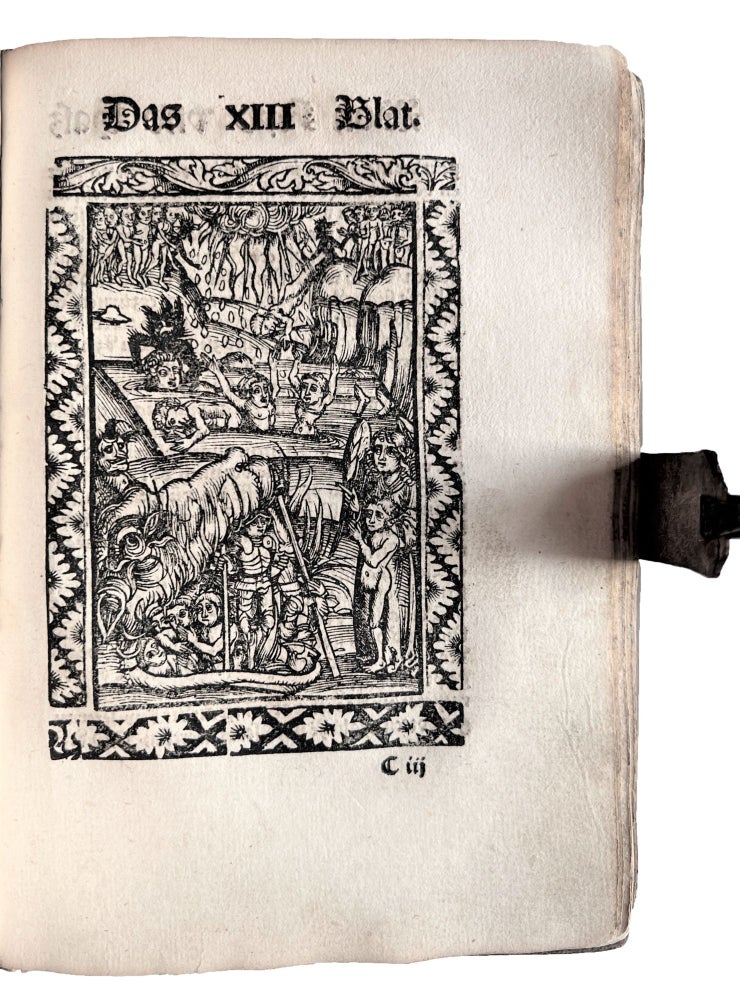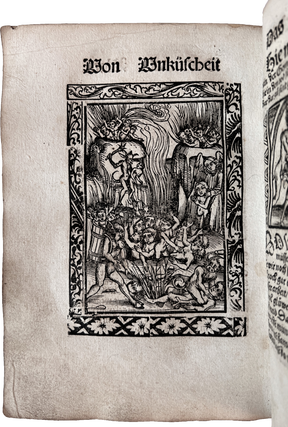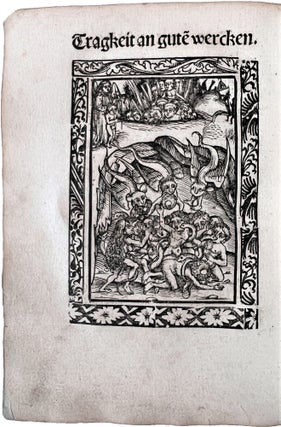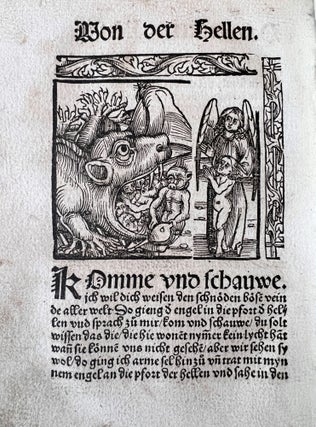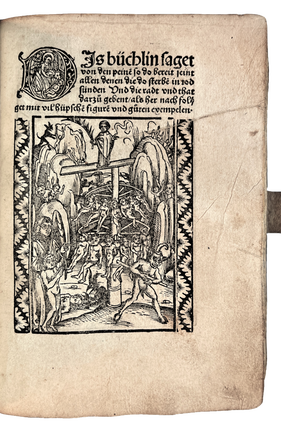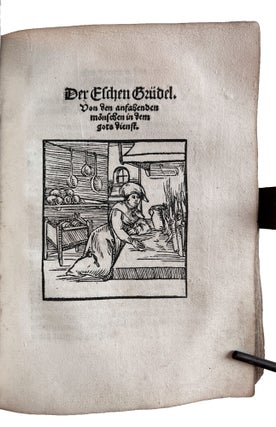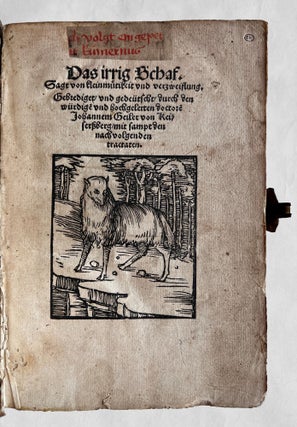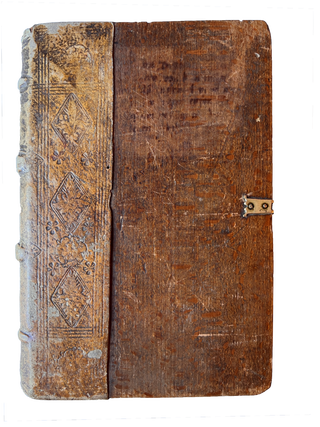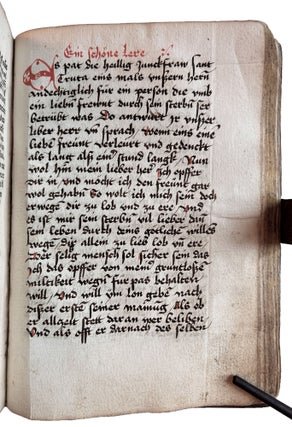Dis büchlin saget von den peine(n) so do bereit seint allen denen die do sterbe(n) in todsünden. Strassburg: [Matthis Hupfuff], 1509.
Bound with: GEILER VON KAISERSBERG, Johann (1445-1510). Das irrig Schaf. Sagt von kleinmuetikeit und verzweiflung. Gebrediget und gedeütscht ... mit sampt den nachvolgenden tractaten. [Strassburg]: Matthias Schürer, [ca. 1510].
2 volumes in one, 4to (200 x 138 mm). Büchlin von den Peinen [bound second]: Collation A-K6.4. 49, [1] leaves. 28 woodcut illustrations: 10 full-page cuts, including two repeats, each within a 4-part woodcut ornamental border, all but one depicting the torments of Hell; 18 half-page or slightly smaller cuts, of which 10 are printed from two adjacent blocks, all but one with one to three border blocks; 2 historiated woodcut initials.
Geiler: 7 parts, with separate title-pages and quiring (for collations see Adams): Das irrig Schaf: [40] ff., last leaf blank; Der hellisch Low: [34] ff.; Die Christenlich Künigin: [30] ff., last leaf blank; Der dreieckecht Spiegel: [36] ff; Der Eschen Grüdel: [28] ff., last leaf blank; Das Klappermaul: [10] ff., last leaf blank; Der Trostspiegel: [24] ff., last leaf blank, used for the second leaf of the two-leaf manuscript (see below; the first leaf being inserted with its stub visible between fols. EE1 and EE2). Gothic types, 20 lines. A few marginal chapter numbers; initial spaces with guide letters. The seven title-pages each with a different woodcut illustration, that for the Dreieckecht Spiegel signed H G. Rubrication: capital strokes in red in most of the tracts.
Condition: sewing of first and last quires slightly loose, occasional marginal dampstaining. Irrig Schaf title-leaf nearly detached and a bit stained and frayed; a word censured on f. A5r, f. B1 with closed tear affecting a letter; Büchlin with crease to title-leaf (before printing), some marginal soiling, short marginal tears to a couple of leaves.
Binding: contemporary South German half blind-stamped alum-tawed pigskin and wooden boards, sewn on paired single sewing supports. The leather decorated with quadruple fillets stamped with a repeated rhomboid foliate tool, large and small rosettes, and another indistinguishable tool, single fore-edge clasp, plain pastedown endleaves, no free endleaves, no headcaps, traces of lettering on front cover from a removed early manuscript label, tabbed comb spine lining, visible after the first quire and before the last quire, cut from a 12th-century manuscript on vellum written in a Carolingian minuscule; rubbed, a small old patch repair near lower hinge, a couple of wormholes to front cover.
Provenance: scattered marginal corrections and crossed out words in the first two Geiler tracts; contemporary three-page manuscript account of a vision of St. Truta (Gertrude) bound between the two works (details below); early parchment label on first title (cropped), in red ink; trace (yellowish square) of a removed book label on title verso; Ernst Kyriss (1881-1974), scholar of fifteenth-century gothic bookbinding stamps, his small ‘EK’ inkstamp on first title.***
A superb Sammelband of medieval christian fables, containing a UNIQUE ILLUSTRATED ACCOUNT OF HELL AND ITS PUNISHMENTS, bound with the first edition of a collection of moralizing tales by the popular preacher Geiler von Kaisersberg, which includes the FIRST ILLUSTRATED PRINTING OF THE CINDERALLA STORY. This large-margined, unpressed copy, from the library of Ernst Kyriss, also includes a contemporary manuscript account of a vision of the mystic and nun Saint Gertrude.
1) Büchlein von den Peinen:
Second and last edition, following that of Bartholomäus Kistler in 1506, of an anonymous account of a soul’s guided tour of the underworld in the company of a guardian angel, illustrated with extraordinary full-page woodcuts by an anonymous Formschneider (possibly Kistler). Combining two popular medieval legends, the Vision of Tnugdalus (or Tundale, or Tondal), and the Vision of Lazarus, the text is unique to these two printed editions. Long misattributed to Kistler, this 1509 edition was in fact printed, using the same blocks, by the Strassburg printer Matthias Hupfuff, who had recently acquired Kistler’s stock. No copies of either edition of this important German woodcut book are held by American libraries.
The text is in two parts. The longer first part, relating a voyage to Purgatory and Hell, describes the creative variety of punishments inflicted for each of the Seven Deadly Sins. This account essentially derives from the popular medieval legend of the vision of the Irish knight Tnugdalus, recounting his involuntary voyage through Hell and Paradise accompanied by a guardian angel. The Tundale tale was the most widely disseminated of several otherworld voyages that originated in the 12th century. “The most important otherworld vision of the high Middle Ages” (Dinzelbacher, p. 112), “the most popular and elaborate text in the genre of visionary infernal literature" (T. Kren, Illuminating the Renaissance: the Triumph of Flemish Manuscript Painting in Europe [2003], no. 14, p. 112), it contained “the most precise and detailed fictional account of the Christian afterlife before Dante” (Foster, ed., Three Purgatory Poems [2004], intro. to the Vision of Tundale). Tundale’s vision circulated widely in manuscript, in various Latin and vernacular verse and prose recensions, and was also familiar to readers from its inclusion by Vincent de Beauvais in the Speculum historiale (Palmer. p. 157). German vernacular versions of the separate Tundale tale were particularly well represented in manuscript and print: of the 30 printed editions listed by Palmer, 20 were in German (all but four of the latter illustrated), most surviving in one or two copies. One can never be reminded too often that “such popular illustrated books evidently had poor chances of survival, and we must assume that there were in fact many more than the twenty editions known to us today” (op. cit., p. 158).
A similar medieval tale, featuring Lazarus, who relates his voyage through purgatory and hell after returning from the dead, circulated in Latin, German and especially French versions. Unlike the Tundale tale, in which the narrator not only views but is forced to suffer along with the souls in Purgatory, the “Lazarus of the Traité des peines d’enfer simply [witnesses] the torments for the Seven Deadly Sins.... Each vision begins `iay veu’ and the illustrations present tableaux of the perpetrators of a particular sin, from which the visionary himself is excluded” (Palmer, 166). The compiler of the Büchlein von den Peinen combined these two legends: the vision of Tundale (der Ritter Tundalus) is here spoken by Lazarus, who must himself endure the punishments. The compiler’s source for Lazarus’s infernal voyage through Purgatory was the French treatise Les Peines d’enfer, published as part of Guy Marchant’s April 1493 edition (GW 5908) and Verard’s 1492 Ars moriendi (GW 2586). In the Büchlein von den Peinen, our compiler (whom Palmer identifies as Kistler) “took the text of Lazarus’s vision from the version of the Traité des peines d’enfer contained in the Kalendrier des bergers and then augmented the description of the punishment for each sin by adding extensive texts extracted from the German text of the Visions of Tondal. For these texts [Kistler] used the German translation from the printed Tondolus edition that he himself [had] published [GW 12835], i.e., recension D” (Palmer, p. 162; cf. Verfasserlexikon 2 vol. 9: 1144).
Following the illustrated descriptions of the punishments of Purgatory, Lazarus’s accounts of Lucifer in Hell and of Paradise are copied verbatim from that same Kistler edition of the Vision of Tundale. The second part of the book contains 30 “exempla” (some are just pious admonishments) from various Latin sources, relating to the afterlife, Purgatory and the horrors of hell. “A single Latin source for this material has not been found” (Palmer, p. 166).
The illustrations:
Each of the seven sins and corresponding punishments is illustrated with two woodblocks, one full-page and one smaller. The seven full-page woodblocks (two are repeated) depict the gruesome punishments of souls who have succumbed to pride, lust, avarice, anger, envy, gluttony or sloth. Sinners spin on spiked wheels, are cooked in cauldrons, roasted on gridirons, shot out of cannons, immersed in frozen lakes, forced to eat toads and snakes, and devoured by snakes and winged lizards. In every woodcut the naked soul of Lazarus and his angel-guide perch on the side, watching.
These woodcuts cleave to the text in most details, showing that they were produced (or commissioned) by Kistler for the Büchlein von den Peinen, either for his 1506 edition or, as appears likely, for an earlier edition, since lost. Most of the cuts were used in Kistler’s aforementioned undated edition of the German Tundale text (GW 12835, of which 2 copies survive), published probably after 1500. The iconography (described in detail by Palmer), does not, however, match the Tundale tale; instead it precisely illustrates descriptions from the present hybrid text, and therefore can be assumed to have been produced specifically for the Büchlein von den Peinen. While most of the cuts illustrate details of the visions as described in the text, occasional elements betray different sources: the cannon motif, for example, is found in neither the Tundale nor Lazarus visions. Palmer concludes from certain details that the wood engraver was influenced by and may have had access to Franco-Flemish illuminations, or to copies made from them.
The full-page cut of Lazarus in the house of Sion the Leper, used as the title woodcut of the 1506 edition, and appearing on the title verso here, was used in a pamphlet printed by Kistler in 1500 (GW M17702). Some of the smaller woodcuts depict the relevant sins as a man or woman astride various animals while accosted by devils. “These illustrations are clearly related to a well-known set of French manuscript illustrations of the vices riding animals, and to a German printed broadside in Vienna, but the iconography is distinct and an exact parallel is not recorded” (Palmer, p. 163). The small cuts for pride (Hoffart) and envy (Nyd und Hass) may stem from different series. The allegorical cut for Hell shows souls in the monstruous Hellmouth; this illustration and those illustrating Paradise, most printed from two blocks, follow the iconography of the “regular” Tundalus editions. The right-hand block of all but one of the two-block illustrations shows the angel and the naked soul of Lazarus; these are printed from two alternating repeated blocks. The exception is the illustration on G5v, showing a house on the left, and a soul leaving a dying man on the right. (One illustration was printed from three separate woodblocks, the larger pictorial block having split through the middle vertically.)
Palmer’s assertion that the blocks may have been cut by Kistler is unproven but not wholly speculative, as Kistler was known to have been an illuminator, painter, and “Kartenmaler.” All of the blocks, as well as the woodcut initials, were acquired by Hupfuff from Kistler, along with his bookshop, in 1509, soon before publication of this edition. Mathias Hupfuff, active from 1498 to 1516, published more vernacular German works, mostly illustrated with woodcuts, than any other Strassburg printer-publisher of the time (Duntze, p. 7). Most are now extremely rare. This one is no exception: only six copies of the 1509 edition are recorded. Kistler’s 1506 edition survives in three copies. Of these nine copies containing this marvelous suite of woodcuts, none are found in American libraries.
References: VD 16 V 2555; Oliver Duntze, Ein Verleger sucht sein Publikum, Die Straßburger Offizin des Matthias Hupfuff (2007), pp. 153-4 & no. 143; Schmidt, Répertoire bibliographique strasbourgeois IV, p. 10, no. 26; Benzing, Bibliographie Strasbourgeoise: bibliographie des ouvrages imprimes a Strasbourg ... au XVIe siècle (1981-1986), 450; cf. Weller, Repertorium typographicum. Die deutsche Literatur im esten Viertel des sechzehnten Jahrhunderts (Panzer, Annalen part 3, 1864), p. 40, no. 354 (1506 edition); Muther, Die Deutsche Bücherillustration der Gothik und Frührenaissance (1884), 603 (1506 ed.). On the text and illustrations see Nigel Palmer, “Illustrated Printed Editions of The Visions of Tondal from the late fifteenth and early sixteenth centuries,” in T. Kren, ed., Margaret of York, Simon Marmion, and The Visions of Tondal (1992), 157-166; Dinzelbacher, “The Latin Visio Tnugdali and its French Translations,” in Kren, Margaret of York, pp. 111-116; Verfasserlexikon 2 (= Die deutsche Literatur des Mittelalters: Verfasserlexikon. Zweite ... Ausgabe, 2010) 10: 409-410 (Visio Lazari, III: these editions) and cf. 1: 108-111, 5: 1231-1233, and 9: 1142-1146 (Visio Tundali). On Hupfuff cf. Reske, Buchdrucker, 949-951. On B. Kistler as artist, see Thieme Becker 20:390, and Kristeller, Strassburger Bücherillustration (1888), 54.
2) Irrig Schaf: Johann Geiler from Kaisersberg, Switzerland, spent three decades preaching at the cathedral of Strassburg, urging reform not of the Church but of its members. Geiler’s sermons, delivered in colorful and often down-to-earth language, combined great erudition with uncommon exempla. Many were transcribed by contemporaries. Geiler himself adapted the seven tracts in this volume from moral sermons by the French theologian and reformer Jean Gerson (explicitly mentioned several times in the tracts), whose works he had edited from 1488 to 1502. The tracts were probably distributed as individual pamphlets before being collected in this volume, published around the time of his death. Most popular was the Trostspiegel, a “mirror of comfort” first published in 1503, and the most often reprinted of any of Geiler’s works.
But best known today is the fifth tract, the Eschen Grüdel, considered the first printed appearance of the ancient tale of the cinder girl, published as Aschenputtel by the Brothers Grimm. In Gerson/Geiler’s treatment, the figure of the Eschen Grüdel, who stands in for the humbly suffering soul, is a nun, and her persecutors are not stepsisters but a mob of her spiritual sisters, who mock her as an imbecile, exclude and enslave her. Her rescuer is a holy man who recognizes her sainthood. The title woodcut of a woman kneeling alone in a scullery is considered the earliest printed illustration of Cinderella.
References: VD16 G 764, G 723, G 733, G 738, G 760, G 768, G 811; Goedeke I:400,15; Schmidt, Répertoire bibliographique strasbourgeois VIII (Schürer), no. 43; Adams G-320; Leon Dacheux, Die ältesten Schriften Geylers von Kaysersberg, no. 47 (pp. 55-57); Muther, Die Deutsche Bücherillustration der Gothik und Frührenaissance, 1434 (1514 edition).
3) Bound between the two printed works is a three-page contemporary manuscript in German, on two leaves (the first leaf is inserted, with a stub, the second leaf is the final blank of the Trostspiegel), in a neat upright German gothic hand in brown ink, 22-24 lines, justification approx. 150 x 95 mm., drop-title Ein schöne lere in red ink, 2-line opening initial and capital strokes in red; incipit: "Es pat die heillig Junckfraw Sant Truta eins mals unßern hern[n andechtiglich für ein person die umb ein lieb[e]n frewnt durch sein sterb[e]n ser betrübt was [i.e., war?] ...".
The text relates a vision of St. Gertrude of Helfta (Gertrude the Great, 1256-1301 or 1302), the German Benedictine nun and mystic. Named here as Truta, she calls on Christ to help comfort a person who is mourning the loss of a friend. At the end Christ gives Truta two golden rings and a precious crown, and she declares that she is his Bride. The situation, vocabulary and imagery evoke and appear to be adapted from the German version of Gertrude’s Legatus divinae pietatis, the Botte der götlichen miltekeit, which circulated widely in the 15th century and was first printed in Melchior Lotter’s edition of 1505 (Das Buch der botschaft oder Legatio, VD 16 M 1785: Leipzig copy digitized: see particularly fols. viii-ix). Notable is the narrator Truta’s role, in this manuscript, as the “mouthpiece” of Christ, and the use of mystical marriage imagery, which played a central and influential part in her and her fellow sisters’ mystical writings (all but book 2 of the 7-book Legatus are now ascribed to other anonymous authors, thought to be fellow sisters of the Helfta convent). The relationship of this manuscript to the Botte tradition would repay further study.
Vernacular devotional texts were typically read by women (cf. Kren, Margaret of York, p. 42). The likelihood that this volume may have been assembled for a woman’s use is supported by the presence of this manuscript account of a vision of one of the most important medieval female mystics.
Cf. Verfasserlexikon 2 3: 9-10; Racha Kirakosian, “The Earliest Transmitted German Redaction of the Legatus: Gotha, Forschungsbibliothek, Chart. B 269,” Analecta Cisterciensia 2019 (69): 178-197.
The binding of this volume exhibits structural characteristics that point to Bavaria or South Germany, particularly the sewing on paired single supports (instead of double supports), and the use of tabbed spine liners (here composed of very early parchment manuscript waste): “comb spine linings in which small tabs of parchment are left at the inner end of each of the slots cut across the lining for the sewing supports and which are folded around the outermost gatherings on both sides of the bookblock to act as external sewing guards” (Ligatus). Grateful thanks to Dr. Nicholas Pickwoad for these details. Item #4197
Price: $44,000.00

